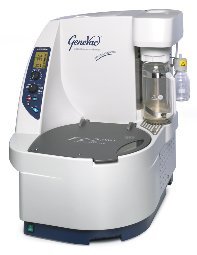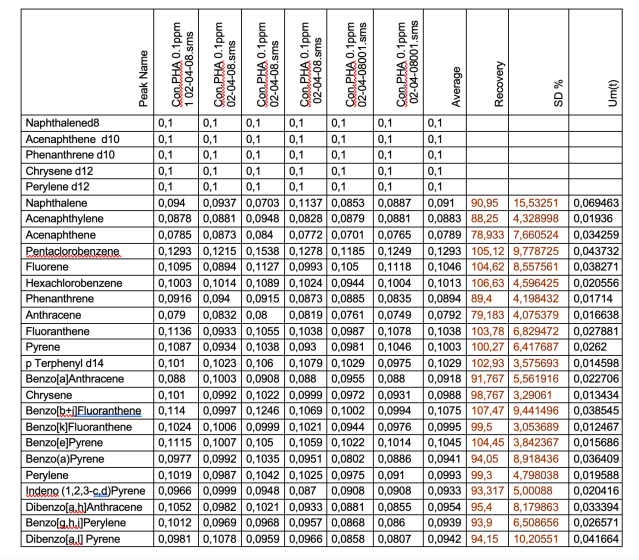By: Dr. Raffaele Faita, Dr. Agostino Brunetta
Introduction
Leochimica Laboratories were founded in 1980, and are at the cutting edge of research into newmethods for environmental analysis. Working in a range of areas under the heading of Environmental Analysis, they cover food toxicology, beverages, occupational hygiene and safety. Working with academic partners, Leochimica seek to continually improve their analytical methodology, to the benefit of all.
This paper follows their evaluation of a new technology, the SampleGenie™, which enables largevolumes of solvent to be concentrated directly into a 2ml GC vial. If this technology proves suitable it can be used to eliminate transfer of samples between vessels at the concentration stage, and so can help to eliminate potential sources of loss, common to all laboratories.
SampleGenie
SampleGenie is a device consisting of a glass funnel which has a small vial sealed to the bottom creating a vial with a much larger volume. The SampleGenie and vial assembly (Figure 1) is designed to be used in a Genevac evaporation system and used to concentrate the large sample directly into the small vial eliminating the need to transfer samples between vessels after the concentration stage. A range of volumes are available, 60ml, 120ml, and 200ml. Due to the costs of the precision with which the SampleGenie is made, the parts are re-useable, therefore a key consideration is cleaning of the flask, and the elastomeric material which forms the seal between flask and vial. This study considers these issues, and evaluates the recoveries of a number of analytes when using the SampleGenie system.
Figure 1 – SampleGenie
Selection of systems shown with arrangement sketch below.
Key
Dark blue – flask
Red – seal
Light blue – vial
Green – adaptor

Evaluation of the SampleGenie
The SampleGenie was evaluated using a Geneva EZ-2 evaporation system (figure 2) to determine the recovery ofPolycyclic Aromatic Hydrocarbons (PAHs) and pesticide analytes following concentration from a large volume ofsolvent. The recoveries were compared to the current methods used. The “memory” effects of reusing the SampleGenie components were also evaluated.
Methodology
Standards of PAH mixture, Pentachlorobenzene and Hexachlorobenzene were prepared in
two different solvents, Hexane and Dichloromethane (DCM). The concentration of these analytes (when concentrated from 50ml to 1ml) was calculated to be 0,1 mg\l PAH, 0,123 mg\l Pentachlorobenzene, 0,098 mg\l Hexachlorobenzene. A 50ml aliquot of each solution was transferred to a 60ml SampleGenie containers and to 60ml glass ASE vials.
Figure 2 – Genevac EZ-2 Evaporator

Hexane Solution Concentraiton
Batches of 6 ASE vials (3 per holder) containing the standard hexane solution were evaporated by EZ2 at a constant pressure of 75mbar. The method was programmed to run for 1 hour, this being the standard method which concentrates the sample but does not run to complete dryness. To achieve a final volume of lower than 1ml the same method was used and paused every 10 minutes so to stop when the desired volume was reached. 10 to 20 minutes are normally sufficient.
The same condition of a 75mbar constant pressure were used for the samples in the 60ml SampleGenie system (4 sample into each holder). The evaporation method was allowed to run in automatic mode, where the system determines the end of the method. The SampleGenie system has special adaptor which insulates the vial and thereby all but stops concentration of the sample in the vial. Under this condition the EZ2 ran for just over 1 hour before the stopping automatically, leaving a residual volume of approx 1ml in each vial. DCM Solution Concentration
Batches of 12 (6 in each holder) samples in ASE tubes, each containing 50ml of the standard solution in DCM, was performed by running a program ramping pressure from 600mbar to 200mbar in 15 minutes, followed by a further 10 minute ramp from 200mbar to 150mbar and then holding at 150mbar. After 90 minutes, the system was paused and the residual volume in the ASE tube was checked, the run continued but was paused every 10 minutes and the vials inspected so not to go to dryness. The result was that an approx. 1ml final volume was achieved after two hours.
The comparative method in the SampleGenie vials was not done at a later stage, the results follow as partof the long term evaluation.
The recoveries in each vial were determined by GC-MS analysis, the results are shown below intables 1 to 3.
Table 1 – PAH and Pesticides recoveries determined by GC/MS after 50 ml hexane standard evaporated in ASETUBES.

Table 2 – PAH and Pesticides recoveries determined by GC/MS after 50ml hexane standard evaporated in SAMPLE GENIE.

Table 3– PAH and Pesticides recoveries determined by GC/MS after 50 ml DCM standardevaporated in ASE TUBES.

Observations
The EZ2 & Sample Genie performed the concentration of standard solution in Hexane very well; therecoveries are highly consistent and reproducible.
The comparison Sample Genie and ASE tubes shows that both these containers are suitable for methods of evaporation at low final volume, however, SampleGenie permits use of the automatic end run, and leaves the sample in the analytical vial ready for GC-MS analysis injection which is a considerable worksaving.
SampleGenie did not exhibit neither cross contamination effect, nor memory effect. However, it was noted that colour leached from the black elastomer which formed the seal between flask and vial. Inthis case is did not affect our analysis, but may in other cases.
Long Term Evaluation
The above samples were used again to check the intra-run reproducibility after a significant amount of time had passed, 2 months in this study. A new seal material had also been developed which was alsoassessed, a low leachable white fluoroelastomer.
Methodology
Standards in hexane and DCM were prepared as before and six samples (three in each holder) wereplaced in the SampleGenie and evaporated as before, in each case the system was allowed toautomatically stop. The hexane samples took approx. 1 hour 20 minutes to stop, leaving approx.
1ml in the vial. The DCM solution took approx. 3 hours to stop, again leaving approx. 1ml in the vial.The samples were analysed by GC-MS and are shown below in tables 4 & 5.
Table 4 – PAH and Pesticide recoveries determined by GC-MS from hexane standard evaporated in SampleGenie

Table 5 – PAH and Pesticides recoveries determined by GC-MS from DCM standard evaporated in SampleGenie

Conclusions
The EZ2 and the SampleGenie performed the concentration of the hexane and DCM standard very well.Recoveries are highly consistent and reproducible, also for very volatile analytes. The “Inter run” comparison of the hexane Standard Solution evaporation confirms the excellent reproducibility and performances of the EZ2 using the SampleGenie even in different seasons (part 1 was developed inwinter while Part 2 was developed in spring).
The comparison SampleGenie and ASE tubes shows that both these containers are suitable formethods of evaporation at low final volume. The advantage of the SampleGenie is that it permits use of the automatic end of run, and leaves the sample in the analytical vial ready for GC-MS injection.
The new seals tested, the first made of a white Viton® material while the second being a whiteperfluoro-elastomer, were tested. These septa didn’t exhibit the same release of contaminants observed when we had been using the black Viton seal. Even after 20 cycles of reuse results were acceptable.
The throughput of the system comprising the EZ2 and the SampleGenie is lower than the one achieved by using ASE tubes: 8 samples compared to 12 and the concentration times is a little longer for the SampleGenie. Nevertheless the SampleGenie offers the advantage of elimination of the need to transfer the residual volume from the ASE tube to the analytical vial. This delicate step requires working time and may decrease recovery. The balance of these advantages and disadvantages is generally in favour of the SampleGenie, particularly for use with delicate assays.
